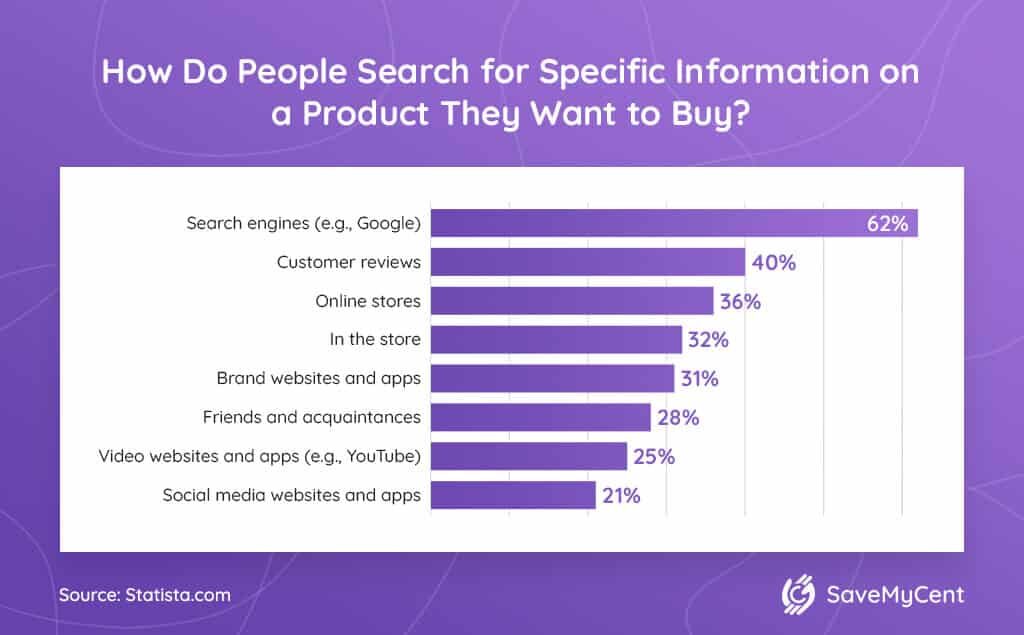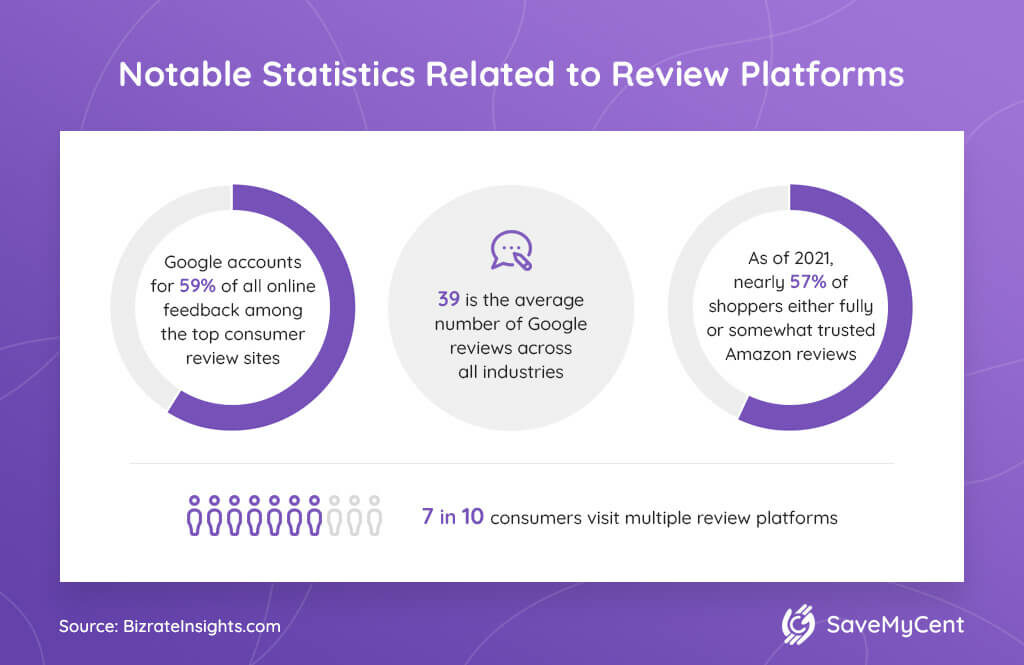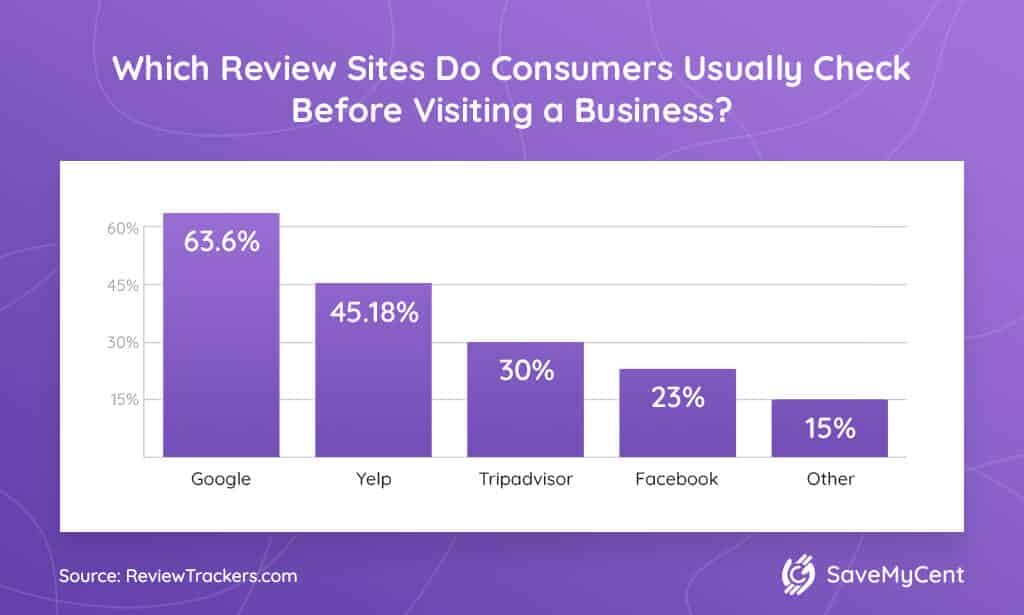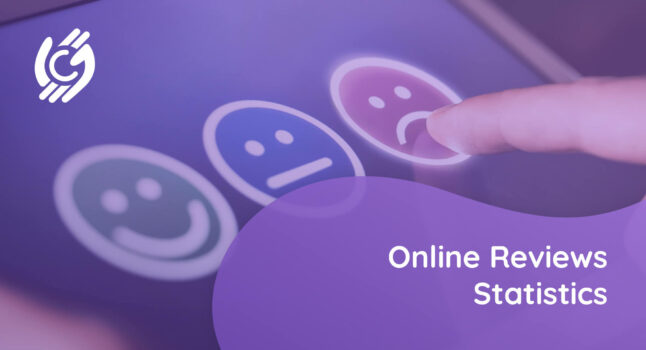Social proof is the unspoken force that fuels our deep-seated biases toward word-of-mouth recommendations. Otherwise known as informational social influence, this psychological phenomenon teaches us how to behave correctly in a given situation based on others’ observable actions and opinions.
In this day and age, there’s no richer source of social proof than online reviews. Self-respecting marketers understand that consumers instinctively seek what like-minded people think about a business, product, or service to avoid disappointment.
Let’s explore the most insightful online reviews statistics out there to see social proof in action and understand the depth of the controversy about it.
Key Stats and Facts About Online Reviews (Editor’s Pick)
- 40% of consumers learn about new products from reviews.
- Nearly 4 in 10 online reviews are fake.
- 50% of Americans hear about the latest products from their friends and acquaintances.
- The average American reads ten reviews before declaring a local business trustworthy.
- No greater than 5% of Americans are bothered by negative feedback.
- About 85% of readers can’t consistently tell authentic and made-up reviews apart.
- 53% of consumers would be willing to use a brand without a 4-star rating.
- 40% of reviewers get a response from the business 100% of the time.
- About 59% of all online reviews are found on Google.
- Over 70% of US consumers are likely to select local brands that reply to customer reviews.
General Online Reviews Statistics
1. 88% of consumers do their homework online before shopping either over the internet or in-store.
(PYMNTS.com)
The advent of the internet has made it painless to absorb pieces of information about brands and their offerings that are otherwise inaccessible. Since you don’t have the monopoly over content, make every effort to positively influence the parties that could put in a good word for your business.
2. Customer reviews are the second-most preferred source of specific product details.

40% of consumers use customer-written feedback for product research. Although more people (62%) turn to search engines, having plenty of quality testimonials on Google can help increase your site’s rankings on Search Engine Results Pages.
If you’re still not completely sold on the importance of online reviews, realize that 6% of Americans believe reviews more than web content found on online stores. This figure speaks volumes about the level of reputation fellow consumers (as information sources) have compared to profit-motivated merchants.
3. 29% of US consumers learn about new products from reviews.
(Statista)
Most Americans hear about the latest products from their friends and acquaintances (50%), so it’s fascinating to see that nearly a third of consumers experience interesting product discoveries from the customers’ feedback. In comparison, online review stats reveal that only 12% of people get product news from celebrities.
To capitalize on this trend, compel existing customers to spread the word about your new or obscure offerings. If you play your cards right, you could use your current customer base to make noise on your behalf without breaking any rules imposed by review sites.
4. A restaurant can generate anywhere from a 5% to 9% increase in revenue for every one-star improvement on Yelp.
(Search Engine Journal)
This effect applies to independent brands only, though. Chain restaurants tend to be more immune to star-rating fluctuation on review platforms. The lesson learned from online review statistics here is that smaller businesses’ profitability is directly tied to the average rating of reviews, so it should be taken seriously and monitored closely.
5. Displayed reviews can boost the conversion rates of lower-priced and higher-priced products by 190% and 380%, respectively.
(Search Engine Journal)
The more expensive the goods go, the more critical the feedback about them becomes. These online reviews statistics about customer use shouldn’t surprise anyone, for consumers feel a greater need to read more testimonials in order to get more assurance about their impending purchase the more money they have to spend.
6. Negative reviews can increase the recruitment cost of employers by 10% per hire.
(Search Engine Journal)
In markets with talent scarcity, companies with a bad reputation have to offer more generous salaries to prized jobseekers. Top talents know their value, and they expect more generous compensation to consider less attractive employment destinations.
For this reason, you need to be extra conscious about your employer brand, or else negative reviews could inflate your staffing costs.
7. 39% of product reviews are disreputable.
(PCMag)
According to 2019 online customer reviews statistics, the industry verticals with the highest percentage of fake testimonials were apparel (46.2%), home decor (45.6%), and electronics (42%). In one study, 24% of the 389 goods evaluated had at least 50% of dishonest feedback.
Since 88% of participants in another survey admitted to having written legitimate reviews, some shady businesses’ testimonial fabricators can be incredibly prolific.
Consumer-Related Online Review Statistics
8. 82% of US consumers check out reviews when searching for local brands.
(BrightLocal)
This 2019 figure decreased by 4% from 2018’s 86%. Moreover, more than half of Americans aged 18 to 54 read customer feedback for local business searches. 47% of their older counterparts do so occasionally.
Researchers are still bullish about the relevance of online reviews in the overall landscape of word-of-mouth marketing. But it would be interesting to know if fewer consumers would search for testimonials in 2020. If a lower number is recorded by the end of the year, it would be a new trend in the making.
9. In 2019, 76% of US consumers trusted online reviews as much as personal referrals.
(BrightLocal)
It’s high, but online reviews statistics in 2018 show that it actually dipped by two percentage points. One explanation of why this stat went down from two years ago was the emergence of influencer recommendations. The stock of social media personalities as brand ambassadors and product or service endorsers has been rising.
Although fewer consumers believed user-generated content as much as they did referrals from family, friends, and colleagues last year, incentivized influencers are less likely to take the crown from unpaid reviewers anytime soon.
The credibility of customer feedback hinges on the belief that it reflects consumers’ genuine feelings toward brands and goods. As long as this notion remains unquestionable, the online review statistics in 2020 won’t drastically change.
10. Nearly 9 in 10 consumers aged 35 to 54 consider online reviews as trustworthy as personal recommendations.
(BrightLocal)
With this statistic, this age group has the most favorable view of strangers’ testimonials on the internet. In comparison, 81% of consumers aged between 17 and 35 don’t mistrust online reviews. Among Americans aged 55 or above, only 71% equate the honesty of these pieces of content to the sincerity of personal referrals.
11. The average consumer reads no less than ten reviews before beginning to trust a local business.
(BrightLocal)
It’s one of the online review stats that prove that you must have numerous testimonials to be more trustworthy. To do this, actively encourage your customers to provide some feedback about your brand, product, or service. This way, your prospective consumers could learn more about your company through your paying consumers’ very words.
Are you hesitant to approach disgruntled customers? You shouldn’t be as statistics show that customers use online reviews, so a healthy mix of good and bad reviews makes your entire treasure trove of feedback seem authentic and believable. Of course, positive comments ideally should exceed the negative ones, so strive to improve the quality of how you do business before anything else.
12. 43% of shoppers trust text-only reviews more than those with visuals.
(Search Engine Journal)
Only 33% of consumers find customer feedback with photos influential, while 24% say video-complemented testimonials impact their buying decisions. Integrating visuals into text-based content may be in vogue, but this practice doesn’t work wonders for online reviews as much as you might think.
13. On average, US consumers dedicate 13 minutes and 45 seconds to read reviews.
(BrightLocal)
Based on 2019 online review statistics, only the 18-to-34 age group recorded an above-average time: 18 minutes and 19 seconds. However, half of all consumers spent anywhere from 1 to 10 minutes of weighing testimonials before deciding. No more than 9% needed 15 to 20 minutes to make up their minds.
Considering how much information a person could absorb in a single minute, you ought to have a sound online reputation management strategy to ensure that your top reviews put your business in the good light.
14. 91% of consumers are more likely to use a brand because of positive feedback.
(BrightLocal)
Statistics about online reviews show that not all good reviews are viewed as positive. Some of them may sound neutral, which some people might interpret as negative. To decide whether the content is positive or negative, many Americans may use the sentiment of the testimonial as the determining factor.
15. Only 5% of consumers say that negative reviews are not a turnoff.
(BrightLocal)
Other pertinent statistics about online reviews show that 13% of Americans are indifferent about bad feedback, while 82% are less likely to use a business due to negative comments.
Obviously, having negative feedback about your brand that’s available for public consumption is bound to repel some people. Although you can’t stop consumers from publishing negative comments about your business (since you can’t please everybody), you could turn the tables.
In hopes of swaying review readers, respond to negative feedback professionally. Use every unfavorable review as an opportunity to show your target audience that you listen to constructive criticism and handle complaints satisfactorily.
16. After reading positive testimonials, almost one-third of US consumers visit the reviewed business’s site.
(BrightLocal & CNBC)
According to the latest online reviews statistics report, the other 28% typically seek out more reviews to validate whether the brand is indeed the right choice. Only 11% of consumers contact the business right after reading good feedback from existing customers. The remaining 28% either visit the business or resume their search for other brands.
One noteworthy takeaway from these figures is the need for a website. If you’re one of the 45% of small business owners who don’t have a company site, you may lose out in the end, no matter how many rave reviews you manage to get.
17. 84% of people can’t always distinguish truthful reviews from bogus ones.
(MarketWatch)
Such a significant number revealed by online review stats is a serious cause for concern, for testimonials are meant to reward respected brands and unmask unscrupulous businesses. Fortunately, there are several ways to spot made-up “customer” feedback.
Research shows that deceivers tend to set the scene instead of commenting on concrete words like price. Unlike truth-tellers, liars are more likely to talk in the first person and use verbs more often than nouns.
Furthermore, generic names, pictureless profiles, repetitive phrases, grammatical errors, misspellings, idiomatically strange uses of language, and unverified purchases are red flags readers should watch out for.
18. Personal computers are the devices of choice for 66% of business review readers.
(BrightLocal)
Online traffic and reviews statistics show that this 2019 figure jumped by three percentage points from the previous year’s. The use of tablets declined by 3%, from 45% to 42%, while the number of review readers who used internet browsers via mobile marginally dipped by 1%, from 57% to 56%.
However, the medium that showed the greatest improvement was mobile apps. According to online review stats, from 32% in 2018, 41% of consumers used them last year.
In the coming years, reviews are likely to be read on smartphones at the same rate as PC or Mac, if not higher. In preparation for this probable future, you’d ensure that your site is mobile-friendly in order to deliver an excellent browsing experience to users who prefer the small screen.
19. 58% of Americans size up online reviews by recency.
(BrightLocal)
In the eyes of nearly 6 in 10 US consumers, newer reviews carry more weight than older ones. Almost as crucial as recency is the overall star rating attached to the feedback. Statistics on online reviews highlight that 56% of people judge reviews based on this metric.
Of all the chief factors in review trustworthiness, pictures are the least relevant. No greater than 32% of Americans find feedback with photos more persuasive.
20. 48% of people let reviews that are two weeks old at the most influence their purchase decisions.
(BrightLocal)
On the contrary, merely 1% of US consumers care about feedback written over a year ago. Only 21% take one-month-old testimonials seriously while another 17% think reviews as old as 90 days are impactful. Needless to say, you ought to receive fresh reviews regularly in order to appeal to at least 86% of Americans.
To compel more of your customers to say something about their experience with your business on the internet, double down on review solicitation. 67% of consumers have already been requested to provide feedback, so you’d do better than most brands if you could convince a higher percentage of your customers to write reviews for you.
21. 53% of Americans would use brands with zero 4 stars.
(BrightLocal)
It’s good news that more than half of consumers would still think about using your business even if your highest star rating is 3. If you manage to earn a 4 star, the other 35% of the market will give your brand some consideration.
The bad news is that 12% of people are unlikely to forgive you for not having 5 stars—a vital rating and reviews statistic you shouldn’t overlook. However, don’t take these figures at face value. Age groups have different standards of star rating acceptability.
As usual, consumers aged 55 or over are the hardest to please; only 7% would turn a blind eye if 2 stars are the best you’ve got. On the contrary, 26% of consumers aged 18 to 34 would be willing to spend money on your products or services without having 3, 4, and 5 stars.
22. Only 40% of reviewers have received a reply to every piece of feedback they wrote.
(BrightLocal)
Another 15% of consumers say they’ve gotten a response to half of the reviews they left, while 17% have been answered at least once.
However, 22% of Americans share that they’ve been ignored completely. No more than 6% of reviewers don’t bother to check whether they’ve received an answer, so make it a point to acknowledge every feedback to let most of your reviewers know that they’re being heard. If you don’t, your neglected and prospective customers may take your nonresponses against you.
23. According to online reviews statistics, 53.3% of reviewing customers expect you to answer back within seven days.
(ReviewTrackers & Convince & Convert)
While the rest don’t expect a reply at all, you’d grab the opportunity to meet high expectations and prove doubters wrong. One week may be plenty of time, but dedicate a reasonable portion of your day to reply to reviews.
If you can’t keep the feedback from piling up, prioritize the older ones. When responding to positive testimonials, give short but appreciative replies. But when it comes to negative reviews, be polite and professional without using jargon to send your message across more easily.
24. 55% of North American customers who’ve left a bad review hope to warn the online community.
(Trustpilot)
Statistics on online reviews show that only 31% of people aim to detail their negative experience, while 16% just want to get back at the company for a bad product, service, or policy. In addition, male customers tend to be more vengeful than their female counterparts.
Nevertheless, 52% of bad review authors like to help other consumers be wiser when making purchase decisions while 31% share some insights to encourage the business to improve.
25. 71% of consumers are likely to choose a brand that has replied to existing reviews.
(BrightLocal)
Reciprocation (or the lack thereof) can make or break a sale. According to online customer reviews statistics, the vast majority of Americans check out feedback about businesses not only to know what others have to say about the brands they’re interested in. They also want to see how well companies respond to comments.
To repay the time your customers spent to write you reviews in kind properly, don’t play favorites. Reply to both negative and positive reviews across different sites.
26. 44.6% of consumers are more likely to use a business that replies to negative reviews.
(ReviewTrackers)
Negative feedback can drive prospective customers away. But you could buck the trend by merely addressing complaints or criticisms in public. Other reputation management statistics show that brands that are most responsive to customers (happy and frustrated alike) are rated highly on third-party review platforms.
Notable Statistics Related to Review Platforms

27. Of all the top consumer review sites, Google accounts for 59% of all online feedback.
(Bizrate Insights)
SEO is one of the chief motivations for marketers making a ton of effort to get their brands reviewed on the platform as much as possible. The search giant has made it clear that having high-quality positive feedback from customers will boost a site’s visibility.
If you hope to increase the likelihood of attracting visitors to your site or your store’s physical location, your website should appear above the fold on SERPS.
28. 63.6% of US review readers gravitate toward Google.

Yelp is the platform 45.18% of Americans consult before connecting with a local brand, followed by TripAdvisor (30.3%) and Facebook (23.14%).
Being visible in said review sites matters in order to reach most consumers in the US. But 14.88% of people use niche platforms to compare brands from specific fields. The absence of your brand in industry-specific review channels may hurt your authority in your domain.
29. Reviews on Google are a vital factor in the local business search for 21% of consumers.
(Convince & Convert)
Although it’s imperative that you receive feedback from customers on different platforms, the bulk of your reviews should be found on Google. 1 in 5 consumers put it on the pedestal, so it’s only natural for you to maximize it if you want its credibility to rub off on your brand.
30. 39 is the average number of Google reviews across all industries.
(BrightLocal)
Based on 2018 Google online reviews statistics, businesses belonging to the hospitality sector had astronomically greater averages. Hotels, restaurants, and bars typically generated 309, 220, and 213 pieces of feedback from customers, respectively.
On the other end of the spectrum, accountants had no more than three reviews on average. Why did these professionals receive such a low number of testimonials on Google? Perhaps it was because most of their prospective clients vetted them through niche review sites instead.
31. The three top-ranked local brands on Google have 47 reviews on average, online traffic and reviews statistics reveal.
(BrightLocal)
Review quantity is just one of the myriad factors that come into play in order to reach the promised land in SEO. But at least you’ll have a specific number to target as you climb your way to the summit of Google local rankings.
32. 3.6 is the average star rating of businesses occupying the top three local ranking positions on Google.
(BrightLocal & Synup)
A 2019 study revealed that more than 8 in 10 shoppers wouldn’t buy from a retailer with less than 3 stars. With this insight, you should get two 5 stars for every 1 star you receive on Google to match the average rating of the search engine’s local ranking leaders.
33. By 2021, reviews on Amazon had been either fully or somewhat trusted by nearly 57% of shoppers.
(Statista, Marketing Land, & Bizrate Insights)
Such a positive perception of customer feedback on the ecommerce platform is a shocker. Not too long ago, a study uncovered that 61% to 64% of Amazon reviews statistics about consumer electronics, cosmetics, and food supplements had not been written in good faith.
Moreover, a recent exposé revealed that dozens of Facebook groups with 10,000+ members were being used to solicit fake favorable reviews in exchange for cash. It’s unclear how many of the current reviews on Amazon are fraudulent, but what’s certain is that merely 6.2% of consumers don’t trust the feedback on the platform at all.
34. New reviews come up on Facebook four times faster than on the other platforms popular among restaurants.
(Convince & Convert)
Such review velocity has made the social network an emerging force in the review space. Despite the short shelf life of typical branded social media content, including Facebook posts, reviews, irrespective of channel, tend to stay relevant much longer.
35. Multiple review platforms are visited by 7 in 10 consumers.
(BrightLocal)
Being frequently reviewed and highly rated on a single site may not suffice to stand above your competitors since people rarely check out only one channel before deciding. To make your presence felt on the right platforms, use an online reviews statistics tracker to learn which third-party sites your customers like to use when sharing their thoughts about your business.
Final Word
Online reviews are not without downsides. Their positives outnumber and outweigh the negatives, though, so they’re worth the pursuit.
However, mastering the art of influencing the most influential voices on the internet is quite a feat. The temptation to skirt the rules can be strong, for it can be challenging to receive tons of favorable feedback organically.
But with dedication and persistence, you could get people talking on the right platforms while conforming with the ethics of review solicitation.
FAQ
Q: How Many People Search Online Before Making a Purchase?
Several studies revealed that consumers do online research before shopping on an ecommerce site or a physical store. This phenomenon has become more pervasive as the internet’s utility has evolved over the past decade.
Brands of all sizes across all industries shouldn’t ignore this continuous trend. With a strong emphasis on abundant UGC, the need for a digital presence is more critical than ever. If you fail to adapt, you’ll stand to struggle to attract new business and stunt the growth of your enterprise.
Q: Do You Check Reviews Before Buying or Booking on the Internet?
Any shopper who doesn’t isn’t using the internet to its full potential. Granted that one should be skeptical of digital content since major platforms are controlled by fallible tech companies and are sometimes strictly regulated by politically motivated governments. However, authentic comments, testimonials, and reviews can reveal the pitfalls of online shopping.
Reading legitimate UGC before purchasing a product, paying good money for a service, or doing business with an organization can help you discover the truth without taking risks. After all, many brands would put their best foot forward to the point of exaggerating claims and lying by omission.
Unlike in the past, contemporary consumers have the luxury of learning from fellow shoppers’ good and bad experiences in order to vet the credentials of businesses effectively.
Q: How Many People Look at Online Reviews?
As already mentioned, over 8 in 10 consumers check out reviews when comparing local businesses. More than half of Americans aged between 17 and 55 read testimonials all the time before buying a product or using a service.
The average US consumer spends nearly 14 minutes to read as much feedback as necessary to feel confident enough to make a purchase decision. Other than perusing testimonials about local brands written by real customers, almost all review checkers are interested in businesses’ responses.
Q: What Percentage of People Trust Online Reviews?
Overall, slightly over three-fourths of US consumers trust online reviews as much as referrals from family, friends, and colleagues. However, the perceived trustworthiness of local business testimonials on Google, Yelp, TripAdvisor, and Facebook vary by age.
Fifty-five-year-olds and the consumers senior to them are usually skeptics; only 22% believe reviews when there’s enough of them while the same number thinks such content is credible only when certain types of businesses are in question.
Younger consumers find online reviews more reliable. 41% of people aged 18 to 34 always trust online reviewers, while 39% of 35- to 54-year-olds share the same sentiment.
Q: What Percentage of Customers Write Reviews?
The latest data reveals that 66% of US consumers have reviewed local businesses online. In 2019, the average reviewer provided brand feedback nine times.
Notwithstanding specific guidelines of several review sites, almost a quarter of brands that have been encouraging customers to leave a review have also enticed prospective participants with rewards, monetary or otherwise.
An incentive could unfairly influence customers’ emotions, defeating the idea of publishing authentic reviews that reflect the actual views and feelings of supposedly unbiased reviewers.
From an ethical point of view, stricter review sites find it unacceptable. From a business standpoint, concerned platforms are worried that dubious testimonials could damage their credibility and legitimacy in the long run.
Due to said online reviews statistics, concerned platforms might reinforce their rules and execute crackdowns to identify and banish cunning local businesses.
Sources:


![35 Online Reviews Statistics to Underscore the Power of Social Proof [2024 Edition]](https://savemycent.com/wp-content/uploads/thumbs_dir/30-Grocery-Shopping-Statistics-1-qbt0se6izvezychk3layf3wzt1cbclk9mj713ajt4s.jpg)
![35 Online Reviews Statistics to Underscore the Power of Social Proof [2024 Edition]](https://savemycent.com/wp-content/uploads/thumbs_dir/15-Online-Consumer-Shopping-Habits-and-Behavior-Statistics-1-qbt16t1fsf59z3jvxtl0ngzfpqaxdis3lvb2016hq4.jpg)



![How to Get Free Clothes From Shein? [2024 Guide]](https://savemycent.com/wp-content/uploads/2023/09/How-to-Get-Free-Clothes-From-Shein-336x220.png)
